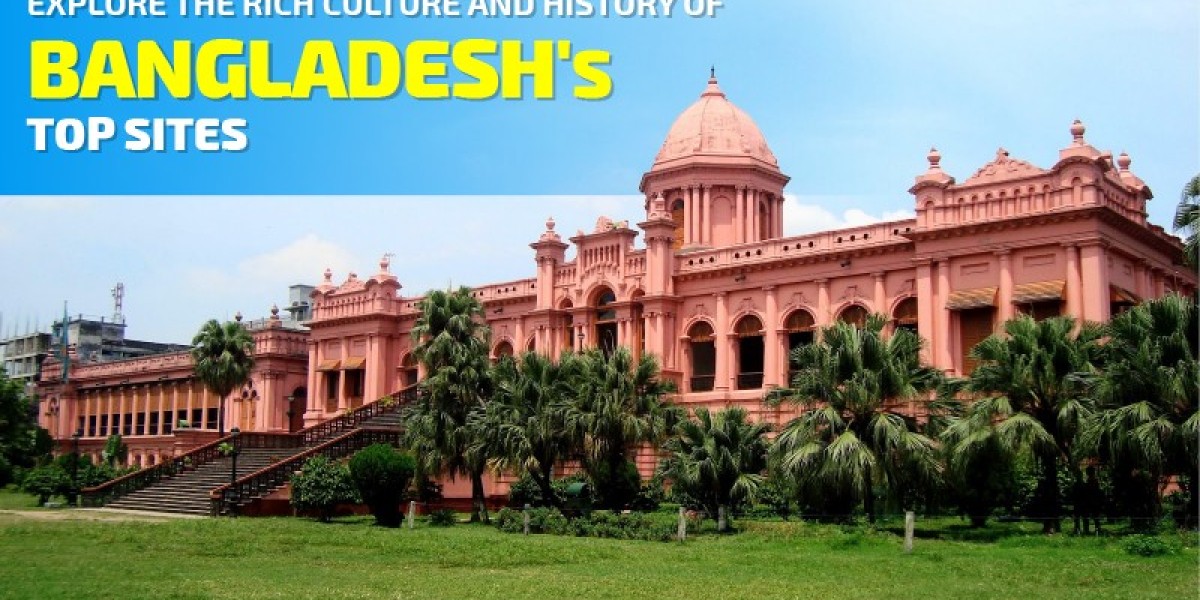Bangladesh, a South Asian nation, is renowned for its varied history and rich cultural legacy. Combining historic sites, lively customs, and age-old traditions, it provides visitors with a singular chance to fully immerse themselves in a world of cultural exploration. From magnificent mosques and temples to historic ruins and breathtaking natural features, Bangladesh's top sites offer history fans, culture vultures, and inquisitive tourists alike an experience they won't soon forget.
The Ancient City of Bagerhat
One of the most important historical sites in Bangladesh is the city of Bagerhat in the southwest, which is a UNESCO World Heritage Site. Several remarkable Islamic monuments can be found there, and in the fifteenth century it was a bustling port city in the Bengal Sultanate. The most well-known of these is the magnificent Sixty Dome Mosque, which has 77 domes and elaborate brickwork. It is evidence of the period's architectural genius.
The Mausoleum of Bagerhat Khan Jahan Ali, the city's founder and saint, is another point of interest. In addition to the tomb, the Khan Jahan Ali Tomb Complex has a mosque, a pond, and a caravanserai, among other buildings. Anyone interested in the history of the area should visit these historical places, which offer a window into the heyday of Bengal's Islamic legacy. For travelers planning their trip, booking flights from Boston to Bangladesh will bring you closer to this historical treasure.
The Magnificent Lalbagh Fort
A famous reminder of Bangladesh's Mughal past, the Lalbagh Fort is situated in the center of Dhaka. It is one of Bangladeshs top sites to visit if you love all things history. The fort, which was constructed by Prince Muhammad Azam in the 17th century, combines architectural, cultural, and military value. The fort is a well-liked tourist destination despite its incompleteness because of its historical significance and stunning architecture.
With its magnificent mosque, the Diwan-i-Aam (the Hall of Public Audience), and the mausoleum of Bibi Pari, a stunning example of Mughal architecture, the Lalbagh Fort boasts a blend of Persian and Mughal architecture. The fort's museum, which displays artifacts from the Mughal era including coins, paintings, and sculptures, is another destination for tourists. It stands as one of the popular tourist destinations in Bangladesh, attracting visitors with its beauty and historical importance.
The Somapura Mahavihara in Paharpur
Somapura Mahavihara, another UNESCO World Heritage Site, is situated in the Paharpur area of northern Bangladesh. This 8th-century Buddhist monastery was once a major learning hub and a popular destination for Buddhist pilgrims from all around Asia. The site includes the remains of more than 150 cells and 45 nearby monastic structures, as well as a central temple encircled by a rectangular courtyard.
The architectural splendor of the Pala period, which is renowned for its Buddhist monastic style, is reflected in Somapura Mahavihara. Numerous stone sculptures, carvings, and relics that offer a fuller knowledge of the religious and cultural traditions of the era may also be found within the complex. It is a crucial location for learning about the Bengal region's Buddhist past, making it one of the most significant historical places in Bangladesh.
The Sundarbans: A Natural Heritage Site
The world's biggest mangrove forest, the Sundarbans, is a vital component of Bangladesh's natural and cultural legacy. The Sundarbans, a UNESCO World Heritage Site, are home to a wide variety of species, including the well-known Royal Bengal Tiger. This natural wonder is a must-see because of its unique flora and fauna, complicated rivers, and impenetrable mangroves.
The Sundarbans are a place of cultural value in addition to its ecological significance. The distinctive way of life of the Sundarbans communities, the local population, is intricately linked to the forest. The rhythm of the forest has influenced their traditions, rituals, and lifestyles, making this an amazing cultural excursion.
The Mosque City of Bagerhat: A UNESCO World Heritage Site
Bagerhat is home to several architectural and religious treasures from the 15th century, including the Sixty Dome Mosque. The 81 domes of the Shait Gumbad Mosque, another magnificent specimen of Islamic architecture, capture the splendor and majesty of the Middle Ages.
Showcasing items from the ancient Islamic Bengal Sultanate, the Bagerhat National Museum, situated within the region, offers insight into the historical, religious, and cultural aspects of the area. This area is a perfect illustration of Bangladesh's rich past due to the integration of architecture, religion, and environment.
The Ancient Temples of Puthia
Puthia, a small town in northern Bangladesh, is well-known for its remarkable collection of Hindu architecture and old temples. Constructed during the 16th and 18th centuries, the temples of Puthia showcase the rich cultural legacy of the Bengal region and the magnificence of Hindu architecture. The most well-known are the Shiva Temple and Govinda Temple, which have exquisite terracotta artwork, exquisite paintings, and detailed sculptures.
For individuals who want to learn more about Bangladesh's religious variety, Puthia is a great place to go. The temples in the area provide a tranquil haven for anyone curious about the region's spiritual legacy in addition to showcasing the craftsmanship of ancient architects.
The Historic Ahsan Manzil
The Nawab of Dhaka used to stay at the majestic palace known as Ahsan Manzil, which is located in the center of the city. Built in the 19th century, this stunning building combines Bengali, European, and Mughal architectural elements to create a superb example of Indo-Saracenic architecture. The palace is now a museum that showcases the rich history of the Nawabi era and the way of life of Bengal's aristocracy during that time.
Ahsan Manzil's lavish rooms allow guests to explore historical furnishings, relics, and portraits that illustrate the Nawab family's significance in Bangladeshi history.
The Ruins of Mahasthangarh
Mahasthangarh, which is situated in Bogura, northern Bangladesh, is one of the country's most significant archeological monuments. Fortifications, temples, and a Buddhist vihara are among the historic constructions that may be found at this Mauryan site, which dates to the third century BCE. Relics from the site provide information about the early civilizations that thrived in the area.
Pottery, coins, and inscriptions are among the artifacts found in Mahasthangarh that indicate the city was a significant center of trade and culture in its day. It offers an amazing glimpse into Bangladesh's prehistoric past and its ties to its surrounding areas.
Bangladeshs top sites beautifully showcase its rich history and vibrant culture, offering travelers a deep connection to the past and a unique cultural experience.
Discover the rich history and culture of Bangladesh's top sites. Book your flight to Bangladesh now on iEagle and start your journey through history!










